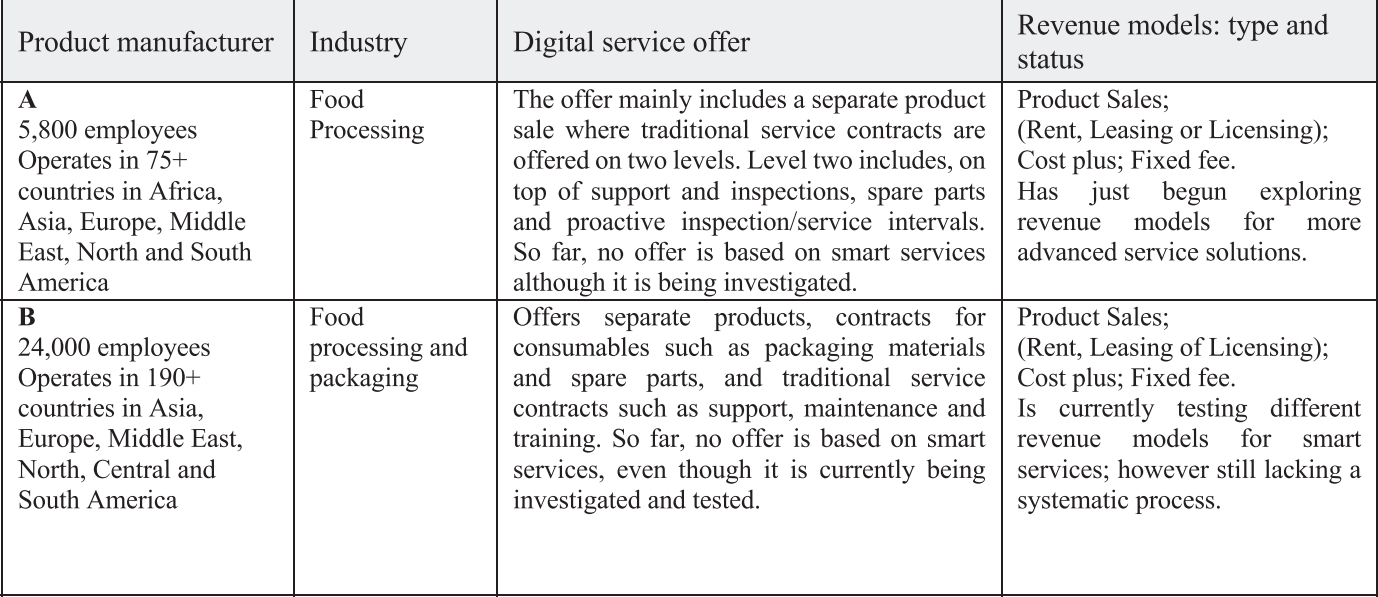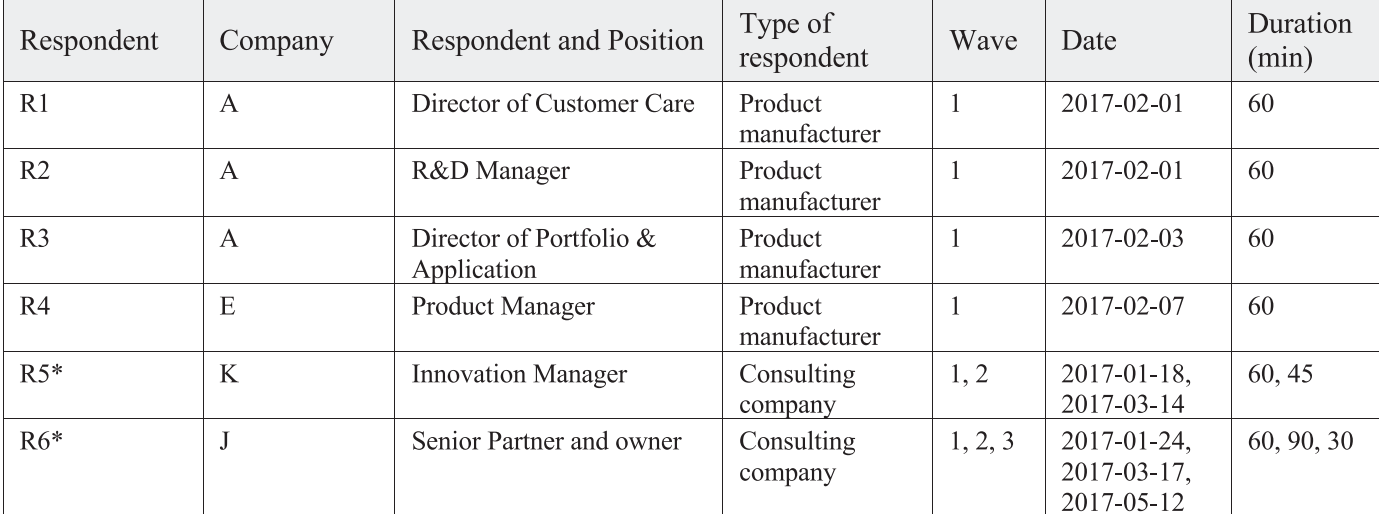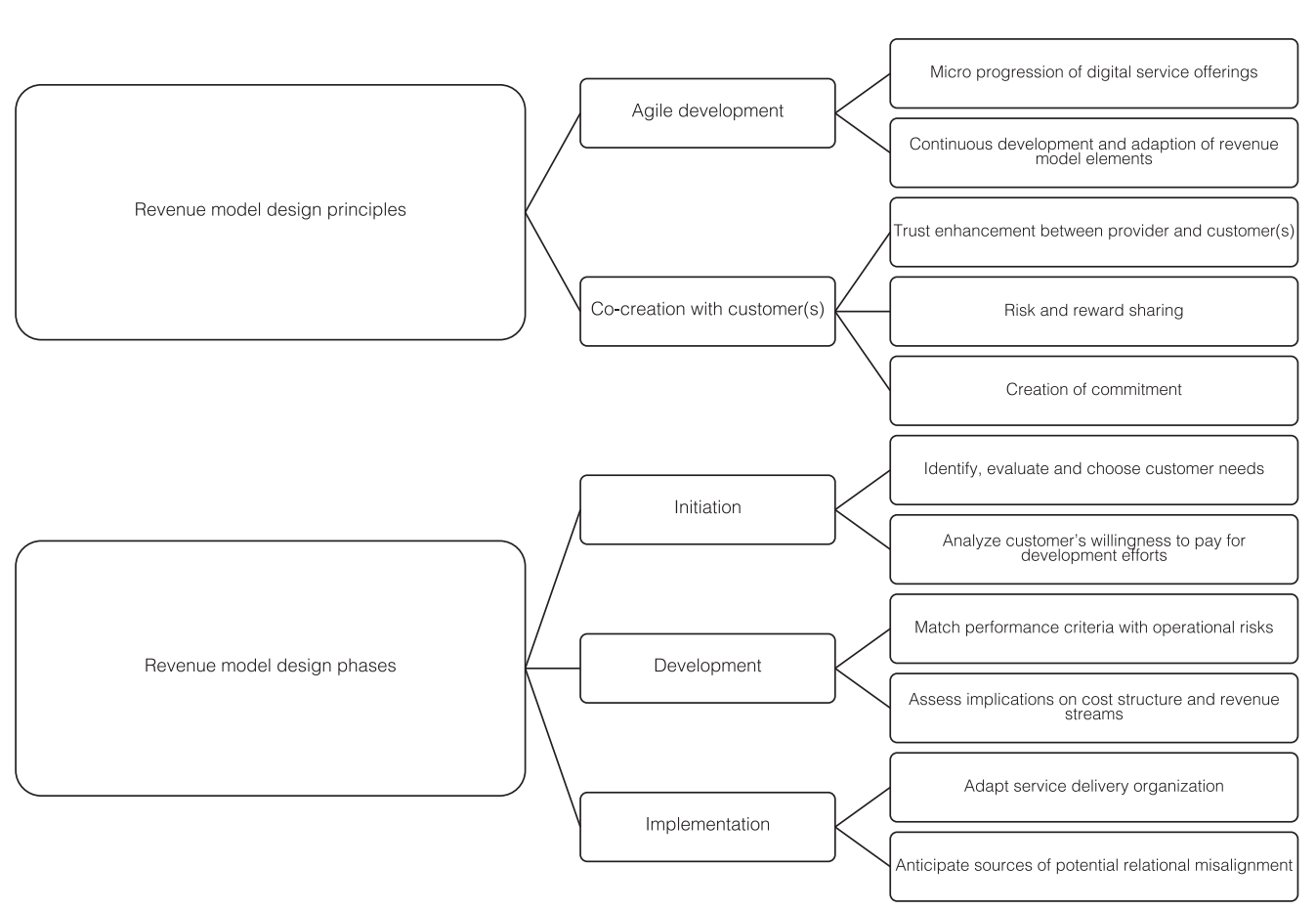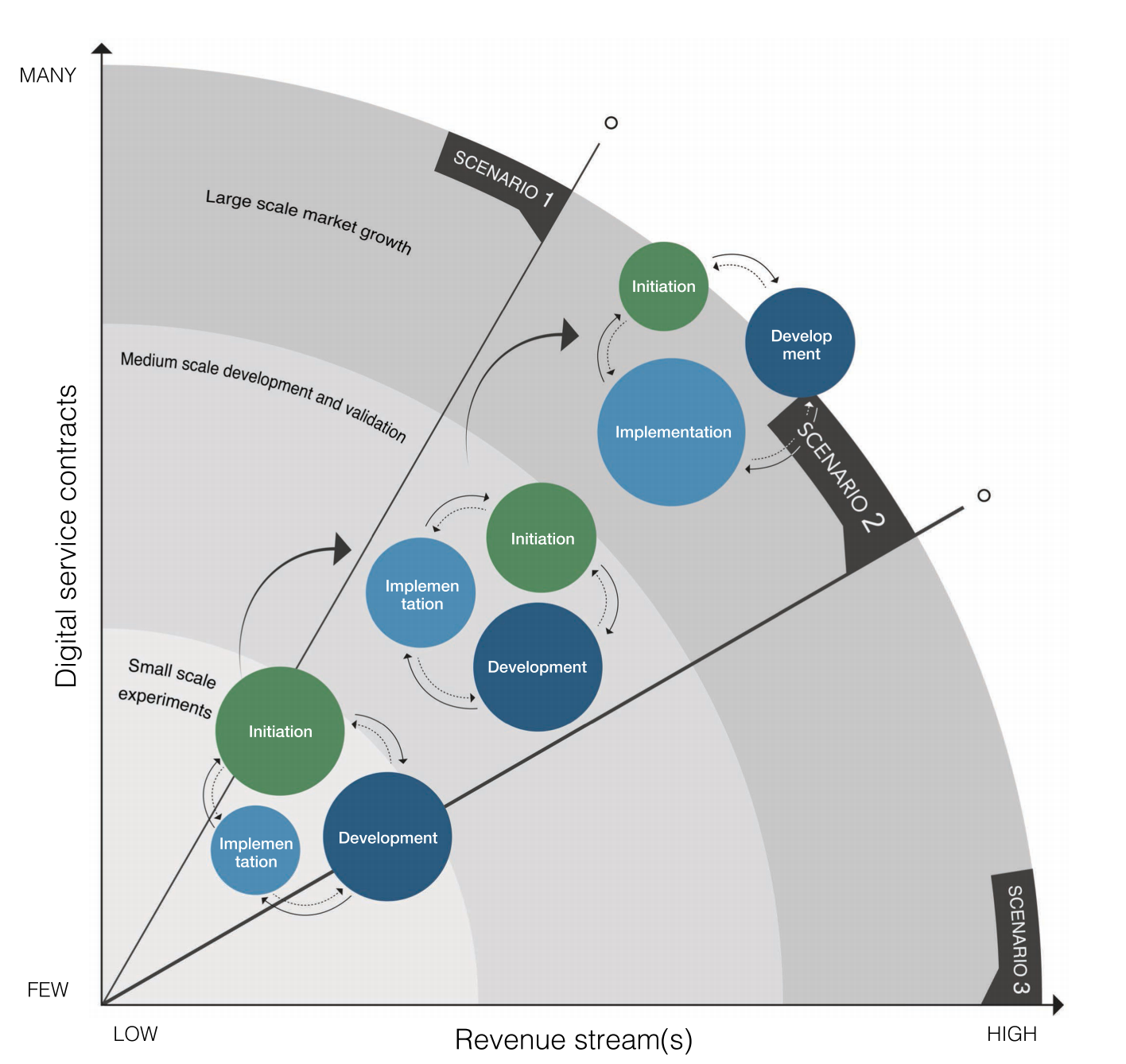Introduction
Manufacturing companies are currently undergoing a digitalization transformation in which digitally enabled, new, and innovative advanced service offerings are being launched. These so-called “digital services” represent a shift in the business logic of manufacturing firms, from up-front product sales to advanced service contracts. This business model shift has profound implications for cost structures, risk management, and revenue streams, provide in manufacturing companies with the key challenge of rethinking how to capture value.
Using a multiple case study of 11 companies, the purpose of this article is to enhance knowledge on how to design new revenue models for digital services. Results reveal a revenue model design framework of key phases and activities that carries implications for the emerging literature on digital servitization, as well as the business model innovation literature. The findings reveal a highly customer-centric, iterative, and agile process where close collaboration with key customers during the early stages guides the framing of revenue models for digital services. For practitioners, it provides hands-on advice on how to implement the design, development, and scaling processes for revenue models in the context of new digital services.
The emergence of digitalization has enabled the application of new digital technologies (such as artificial intelligence, Internet of Things, and big data analytics), which has fueled existing servitization initiatives. At its core, servitization refers to the transformation whereby manufacturing firms create and capture value through advanced service offerings rather than the up-front sale of physical products. According to Parida et al., digitalization typically goes “hand in hand with adopting a servitization strategy”.
These emerging and converging perspectives have gained research momentum under the heading of digital servitization, which refers to the provision of digital services embedded in a physical product. This means that digital servitization transforms the processes, capabilities, and offerings within industrial firms so that increased service value arising from a broad range of enabling digital technologies is progressively created, delivered, and captured.
In practice, physical products are increasingly equipped with processors, sensors, software, analytics, and connectivity, enabling data to be exchanged between the product and the environment, manufacturer, operator/user, and other products and systems In theory, digital services can create closer relationships with customers , improve competitiveness through product differentiation, and generate higher profit margins.
However, recent studies have noted that a “digitalization paradox” occurs, where manufacturing companies are unable to derive business benefits from their investments in digital technologies and expanding servitization portfolio. Many reasons may explain why capturing value from digital services can be challenging for firms as their implementation tends to disrupt and radically change the traditional business logic, the cost structure, and the revenue streams of a manufacturing firm.
For example, digital services imply a more value-based pricing logic, which means that firms need to find new suitable payment intervals and must align customer and provider incentives through performance and price parameters, and new types of contractual agreement. All of these challenges rest on a firm’s revenue model, which needs to undergo substantial modification to meet the specific design requirements of digital servitization.
Digital Servitization and Digital Services
According to prior literature, digital technologies such as sensors, connectivity, and big data analytics act as enablers of servitization and digital service provision. The key premise behind the digital servitization of manufacturing is to provide customers with IT-enabled solutions through the planned integration of products and services. This literature is still in its formative stages, with discussions covered under diverse labels such as advanced services, digitalized productservice systems, smart services, solutions, digital business models, smart and connected products, and digital technologies. This has resulted in fragmentation and a lack of integrated thinking on how companies can profit from digital services.
In this article, we build on servitization research that views digitalization as an enabler of higher value creation, and we call for attention to be directed to the capture of value, The authors conceptualize digital servitization in terms of “digital services” where technology-enabled advanced services rely heavily on digital components embedded in physical products. Thus, digital services refer to bundles of products and services aimed at solving customer problems by delivering targeted results or outcomes. Achieving this purpose invariably involves high complexity since the service provider needs to build connectivity into the product itself and—most importantly—respond proactively to the knowledge that stem from the product’s usage and surrounding environment. Take, for example, Komatsu Forest’s proactive service agreement, ProAct 2.0, which offers contractors optimized equipment uptime through proactive maintenance and spare-part management, all enabled by smart, connected machinery monitored by the provider’s service workshops.
Revenue Models for Digital Services
The virtual servitization literature lacks a unified definition of what a sales version is. Building on commercial enterprise version literature amit and zott view a revenue model as “…the precise modes wherein a commercial enterprise model enables revenue generation”
A extra service-orientated definition is supplied through rapaccini who adapted malleret’s perception of a sales model as “the manner thru which the quantity of cash to be paid
for the received services is determined”, by using assessment, holds that a sales model describes “…the sales resources, their quantity and their distribution” view the sales model as one of two additives in the earnings method (the alternative being value structure, which does now no feature in this cutting-edge study) and describe it as “how much money can be made: fee x volume”, in which volume can be thought of as marketplace length and purchase frequency. Primarily based on those previous definitions, the revenue version in this text is described as a sales version determines the revenue assets, their quantity and distribution, which permit a focal firm to seize price from virtual services.
The literature on sales fashions for virtual services in general, and how to layout revenue models specifically, are nascent. Revenue models are discussed broadly speaking in two distinctive literature streams—business fashions and pricing—which both touch on sales streams and price capture mechanisms. But, only a few researches have the revenue model as the important thing awareness even though its significance for profitability and long-time period competitiveness is widely known. By way of comparison, the enterprise version literature generally considers the sales model as a subcomponent of the overall commercial enterprise version. But, quite frequently in business version studies, the enterprise version and the sales version are used interchangeably which creates ambiguity.
However, amit and zott factor out that the business model and the sales model are “complementary but distinct principles,” with the enterprise version referring commonly to price advent and the sales model worried specially with price capture and appropriation. There are many studies on commercial enterprise model innovation and how to layout its components . But, the revenue model itself stays at the outer edge of take a look at wherein it’s miles defined as an aggregated sub construct of commercial enterprise model innovation. The fashion appears to be to stress its importance, presenting examples of various sales models that firms use however supplying little or no steerage on the suitable desire of particular sales version and the concept strategies required to develop new ones. A few pupils gift the revenue version as a means to compete and others as a mechanism to cope with uncertainty.
Research Design
As prior literature on designing revenue models for digital services is scarce, we adopted an abductive research approach; the abductive approach combines inductive and deductive elements in which prior research helps to interpret emergent findings and guide the constructing of interview protocols, but where codes and themes are still allowed to emerge inductively. Also, this approach allowed us to move between existing literature and the empirical data in an iterative manner so that emergent conclusions could be continuously refined to develop a empirically grounded framework. Furthermore, we chose a case study method because it is considered suitable when collecting qualitative and complex phenomenological data. A case study is also a fitting approach when seeking to answer “how” questions which the case with this article was. Emerging revenue models for digital services in mature man factoring companies constitute the key unit of analysis.
Data Collection
The data collection was organized into three phases. First, we performed exploratory interviews, held an initial workshop, and reviewed prior literature to better understand the contextual issues and practical problems related to revenue models for digital services. Second, we engaged in semi-structured interviews and complementary literature studies, and organized another workshop to address the purpose of the research directly—that
is, how to design revenue models for digital services. Finally, the third phase of research focused on filling the gaps that remained, using confirmation interviews and comparing empirical results with prior literature. Here, a third workshop was organized to obtain feedback on emergent versions of the revenue model design process. Interviews provided the primary source of data. The interviews were undertaken in three waves, one for each phase of the research, amounting to 25 in total.
From these, nineteen were face-to-face interviews and six were carried out by phone or Skype. The first wave of interviews was exploratory, aiming to obtain an overall understanding of the situation and problem. They also validated some ideas prevalent in the existing literature and contradicted others, thereby helping to hone the research purpose. Thus, the respondents chosen for this wave all had experience of driving digitalization initiatives and could offer insights into common challenges that arose when trying to develop new businesses around digital services.
Data Analysis
Due to the study’s abductive nature, data analysis was conducted in parallel with data collection and was continuously compared with prior literature. Data were analyzed by means of thematic analysis. As prior research on revenue model design is scarce, we were especially careful not to “squeeze” data into predefined theoretical categories and, so, we allowed initial codes, subthemes, and themes to emerge without requiring an immediate fit with existing literature. This approach meant we were able to create a thematic map using a four-step coding process, inspired by Braun and Clarke’s six phases form undertaking thematic analysis and Gioia, Corley, and Hamilton’s systematic data analysis approach. The first step—whose purpose was to familiarize ourselves with the data—included reading through the interview material and workshop notes several times to acquire an in-depth understanding of the content. Notes were taken on ideas for codes, themes, and potential findings.
For example, the importance of focusing on cocreation with customers was identified from reading through the transcripts, and then translated into a formal subtheme. The second step—generating codes—used Corley and Gioia’s idea of creating first-order concepts in which respondents terms and phrases were used to identify those parts of the raw data that could explain the phenomena studied in a meaningful way. For example, quotations such as “You must always begin with addressing a customer’s need” and “You cannot solve all problems, you have to make choices on which customer needs are most critical to solve first” generated the code “Identify, evaluate, and choose customer needs.” To stay true to the respondents’ words and formulations, changes to the terms and phrases were kept to a minimum. During the third step—searching for themes and subthemes similarities and differences among codes were analyzed and grouped into themes and subthemes to produce an initial thematicmap. Here, the codes’ connection to existing literature was analyzed to ensure that the themes were appropriately labeled. For example, the subthemes “Initiation,” “Development,” and “Implementation” were combined into the theme
“Revenue model design phases” to represent the processual connection in terms of purpose; that is to say, “how can firms design….”.
Finally, in step four, we created a final version of the thematic map by further reviewing themes, subthemes and codes—first, individually, then, in relation to each other. For example, the initial version of the sub-theme “Agile development” included three codes. However, in the final step the codes “Feedback loops” and “Continuous development and adaption” were combined into “Continuous development and adaption of revenue model elements.” This full set of codes, subthemes, and themes constitutes the thematic map, which creates a visual representation of the process from raw data to final data structure.
Findings
The thematic analysis revealed novel insights into how revenue models are best designed for digital services in the context of a mature manufacturing industry. Specifically, two overarching themes emerged from the analysis that laid the foundations for revenue model development; namely, revenue model design principles and revenue model design phases. The principles describe the underlying logic of the revenue model design process, while the phases represent the more tangible aspects such as the key activities companies undertake when designing revenue models for digital services.
Revenue Model Design Principles
The data analysis reveals two main principles behind the process of designing revenue models for digital services, which are characterized by agile development and cocreation with customers.
Agile Development:
Agile development refers to the iterative sprint of an experimental nature. It relies on design and development processes, including quick feedback loops that enable trial-and-error learning for the development improvement of the revenue model concept.
Micro progression of digital service offerings:
Micro progression logic requires that a manufacturing company address one customer need at a time rather than opting for full coverage of advanced-service contracts, such as complete site optimization where the provider takes over the operation of the customer site from the outset. By adapting a micro digital service approach, providers can better prioritize resources and build customer knowledge that can be applied in subsequent digital service.
Revenue Model Design Phases
The underlying logic behind the revenue model design process can generally be divided into three phases: initiation, development, and implementation. In terms of the interrelationships between these phases, it must be emphasized that they are not perfectly sequential. Rather, the three phases interact in parallel as the emerging revenue model develops. The same process recurs as the revenue model develops scale and new versions of the models are standardized. This reflects the iterative nature of the process of designing revenue models.
The initiation phase aims to create an in-depth understanding of customer needs and problems, followed by the prioritization of specific sets of needs as well as development of the accompanying revenue model concept. These activities are initiated as new business opportunities arise for either the manufacturing company or the customer (i.e., market pull), or simply because the company is interested in moving into digital services (i.e., provider push) and needs to find a profitable revenue model. This phase ensures that actual customer needs are addressed so that customers are willing to pay for the new offering. In the words of one of our respondents:
“The fifirst thing you need to think about is who it is that I am creating
value for, who are the actors and what are they willing to pay for.”




